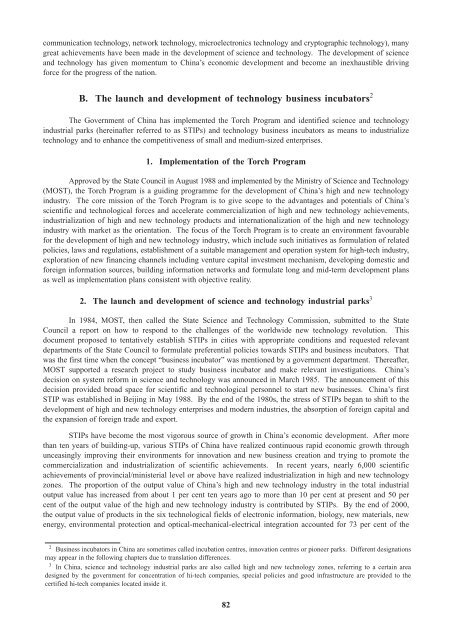iii. promoting business and technology incubation for ... - Escap
iii. promoting business and technology incubation for ... - Escap
iii. promoting business and technology incubation for ... - Escap
You also want an ePaper? Increase the reach of your titles
YUMPU automatically turns print PDFs into web optimized ePapers that Google loves.
communication <strong>technology</strong>, network <strong>technology</strong>, microelectronics <strong>technology</strong> <strong>and</strong> cryptographic <strong>technology</strong>), many<br />
great achievements have been made in the development of science <strong>and</strong> <strong>technology</strong>. The development of science<br />
<strong>and</strong> <strong>technology</strong> has given momentum to China’s economic development <strong>and</strong> become an inexhaustible driving<br />
<strong>for</strong>ce <strong>for</strong> the progress of the nation.<br />
B. The launch <strong>and</strong> development of <strong>technology</strong> <strong>business</strong> incubators 2<br />
The Government of China has implemented the Torch Program <strong>and</strong> identified science <strong>and</strong> <strong>technology</strong><br />
industrial parks (hereinafter referred to as STIPs) <strong>and</strong> <strong>technology</strong> <strong>business</strong> incubators as means to industrialize<br />
<strong>technology</strong> <strong>and</strong> to enhance the competitiveness of small <strong>and</strong> medium-sized enterprises.<br />
1. Implementation of the Torch Program<br />
Approved by the State Council in August 1988 <strong>and</strong> implemented by the Ministry of Science <strong>and</strong> Technology<br />
(MOST), the Torch Program is a guiding programme <strong>for</strong> the development of China’s high <strong>and</strong> new <strong>technology</strong><br />
industry. The core mission of the Torch Program is to give scope to the advantages <strong>and</strong> potentials of China’s<br />
scientific <strong>and</strong> technological <strong>for</strong>ces <strong>and</strong> accelerate commercialization of high <strong>and</strong> new <strong>technology</strong> achievements,<br />
industrialization of high <strong>and</strong> new <strong>technology</strong> products <strong>and</strong> internationalization of the high <strong>and</strong> new <strong>technology</strong><br />
industry with market as the orientation. The focus of the Torch Program is to create an environment favourable<br />
<strong>for</strong> the development of high <strong>and</strong> new <strong>technology</strong> industry, which include such initiatives as <strong>for</strong>mulation of related<br />
policies, laws <strong>and</strong> regulations, establishment of a suitable management <strong>and</strong> operation system <strong>for</strong> high-tech industry,<br />
exploration of new financing channels including venture capital investment mechanism, developing domestic <strong>and</strong><br />
<strong>for</strong>eign in<strong>for</strong>mation sources, building in<strong>for</strong>mation networks <strong>and</strong> <strong>for</strong>mulate long <strong>and</strong> mid-term development plans<br />
as well as implementation plans consistent with objective reality.<br />
2. The launch <strong>and</strong> development of science <strong>and</strong> <strong>technology</strong> industrial parks 3<br />
In 1984, MOST, then called the State Science <strong>and</strong> Technology Commission, submitted to the State<br />
Council a report on how to respond to the challenges of the worldwide new <strong>technology</strong> revolution. This<br />
document proposed to tentatively establish STIPs in cities with appropriate conditions <strong>and</strong> requested relevant<br />
departments of the State Council to <strong>for</strong>mulate preferential policies towards STIPs <strong>and</strong> <strong>business</strong> incubators. That<br />
was the first time when the concept “<strong>business</strong> incubator” was mentioned by a government department. Thereafter,<br />
MOST supported a research project to study <strong>business</strong> incubator <strong>and</strong> make relevant investigations. China’s<br />
decision on system re<strong>for</strong>m in science <strong>and</strong> <strong>technology</strong> was announced in March 1985. The announcement of this<br />
decision provided broad space <strong>for</strong> scientific <strong>and</strong> technological personnel to start new <strong>business</strong>es. China’s first<br />
STIP was established in Beijing in May 1988. By the end of the 1980s, the stress of STIPs began to shift to the<br />
development of high <strong>and</strong> new <strong>technology</strong> enterprises <strong>and</strong> modern industries, the absorption of <strong>for</strong>eign capital <strong>and</strong><br />
the expansion of <strong>for</strong>eign trade <strong>and</strong> export.<br />
STIPs have become the most vigorous source of growth in China’s economic development. After more<br />
than ten years of building-up, various STIPs of China have realized continuous rapid economic growth through<br />
unceasingly improving their environments <strong>for</strong> innovation <strong>and</strong> new <strong>business</strong> creation <strong>and</strong> trying to promote the<br />
commercialization <strong>and</strong> industrialization of scientific achievements. In recent years, nearly 6,000 scientific<br />
achievements of provincial/ministerial level or above have realized industrialization in high <strong>and</strong> new <strong>technology</strong><br />
zones. The proportion of the output value of China’s high <strong>and</strong> new <strong>technology</strong> industry in the total industrial<br />
output value has increased from about 1 per cent ten years ago to more than 10 per cent at present <strong>and</strong> 50 per<br />
cent of the output value of the high <strong>and</strong> new <strong>technology</strong> industry is contributed by STIPs. By the end of 2000,<br />
the output value of products in the six technological fields of electronic in<strong>for</strong>mation, biology, new materials, new<br />
energy, environmental protection <strong>and</strong> optical-mechanical-electrical integration accounted <strong>for</strong> 73 per cent of the<br />
2 Business incubators in China are sometimes called <strong>incubation</strong> centres, innovation centres or pioneer parks. Different designations<br />
may appear in the following chapters due to translation differences.<br />
3 In China, science <strong>and</strong> <strong>technology</strong> industrial parks are also called high <strong>and</strong> new <strong>technology</strong> zones, referring to a certain area<br />
designed by the government <strong>for</strong> concentration of hi-tech companies, special policies <strong>and</strong> good infrastructure are provided to the<br />
certified hi-tech companies located inside it.<br />
82
















